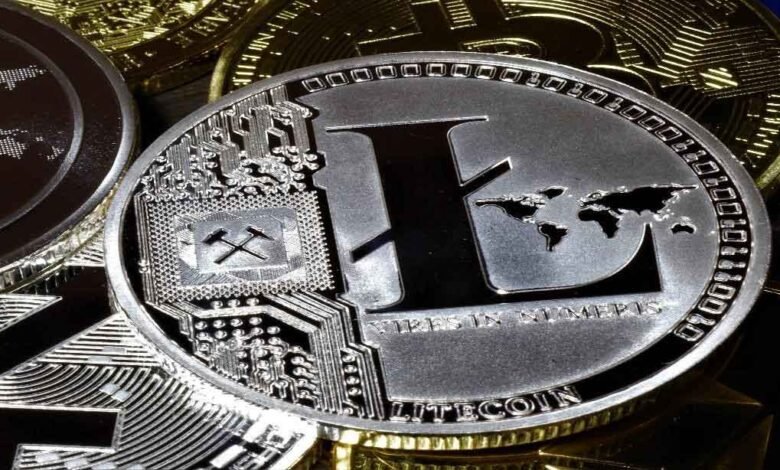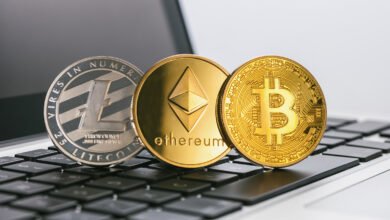What is Litecoin and how does it work?

what is litecoin ? In the world of cryptocurrencies, Litecoin stands out as one of the prominent alternative coins available in the market. Built on blockchain technology, Litecoin has been gaining popularity among users and investors alike.
What is Litecoin? Litecoin (LTC) History
Litecoin (LTC) is a peer-to-peer cryptocurrency that was created by Charlie Lee, a former Google engineer, and released to the public in 2011. Inspired by Bitcoin, Litecoin was designed to offer a faster and more accessible alternative to the leading cryptocurrency.
Charlie Lee introduced Litecoin as “the silver to Bitcoin’s gold,” positioning it as a digital currency that aimed to complement Bitcoin rather than compete with it directly. Lee made several key modifications to the Bitcoin protocol to enhance certain aspects of the network, resulting in a distinct cryptocurrency known as Litecoin.
One of the most significant differences between Litecoin and Bitcoin is the hashing algorithm used for mining. Litecoin uses a Scrypt algorithm, whereas Bitcoin uses the SHA-256 algorithm. This algorithm allows for a more efficient mining process and promotes widespread participation, as it can be mined using consumer-grade hardware.
Litecoin gained traction quickly and established itself as one of the leading cryptocurrencies in the market. Its popularity grew due to its faster block generation time, which is approximately 2.5 minutes compared to Bitcoin’s 10 minutes. This shorter block time enables faster transaction confirmations and enhances the overall scalability of the network.
Over the years, Litecoin has continued to evolve and implement improvements. It has been an early adopter of various technological advancements, including Segregated Witness (SegWit) and the Lightning Network, which aim to improve transaction efficiency and scalability.
Furthermore, Litecoin has gained recognition as a reliable and widely accepted cryptocurrency. It is supported by numerous cryptocurrency exchanges and payment platforms, making it easily accessible for users worldwide.
How does Litecoin work?
After answering the question of: what is Litecoin? It is necessary to shed light on how this cryptocurrency works.
Litecoin and Bitcoin are similar in a number of ways. Proof of work is used by both open-source projects to validate transactions.
However, Litecoin differs from Bitcoin in a few important ways as well. In addition to processing speed, there is the supply problem. Litecoin has an 84 million coin maximum supply, compared to 21 million coins for Bitcoin.
Read About: invest in cryptocurrency
How Litecoin Is Mined
Miners of Litecoin must solve challenging mathematical puzzles known as hashes in order to be granted permission to add new transactions to the blockchain.
The blockchain cannot be amended once a block is closed. The miner receives 12.5 LTC for being the first to correctly solve the hash linked to a transaction using the proof of work consensus technique.
Litecoin mining operations aren’t something you’ll often see running on a computer out of someone’s living room. Hashing demands a lot of processing power, which uses a lot of energy and space.
In actuality, mining farms and pools of cryptocurrency miners employing advanced hardware handle the majority of the Litecoin mining workload.
How Litecoin Halves
Like Bitcoin, Litecoin is divided in half to aid in supply control.
The maximum quantity of Litecoin is 84 million coins. However, miners are paid with freshly created LTC whenever they add a new block to the Litecoin blockchain. If not for the halving, this might lead to an infinite increase in the quantity of Litecoin.
The miner reward for successfully adding new blocks to the Litecoin network is periodically reduced (halved) through a process called halving. In the case of Litecoin, it occurs every 840,000 transactions. Therefore, 50 LTC was the miner reward when Litecoin originally began for adding a new block to the blockchain. That prize has been cut in half over the last few years, to 12.5 LTC as a block payout.
Because Litecoin is so liquid, trading with it is more straightforward. In reality, Litecoin investors will find that shops such as Newegg, SlingTV and even NGOs like the American Red Cross are glad to accept their cryptocurrency.
To pay with LTC, you can also use programs that store digital currencies, such as BitPay or CryptoPay. You can pay someone with LTC using the Binance app if you wish to utilize it for peer-to-peer payments.
How to buy and sell Litecoin?
We strongly advise you to read the “What is Litecoin” section before you start reading this section on how to buy and sell it.
To buy and sell Litecoin, you can follow these general steps:
Buying Litecoin:
- Choose a Cryptocurrency Exchange: Select a reputable cryptocurrency exchange that supports Litecoin.
- Create an Account: Sign up for an account on the chosen exchange. This typically involves providing your email address, creating a password, and completing any necessary identity verification procedures as per the exchange’s requirements.
- Deposit Funds: Once your account is set up, deposit funds into your exchange account. This can be done by linking a bank account, using a credit/debit card, or depositing other cryptocurrencies, depending on the options provided by the exchange.
- Place an Order: Navigate to the trading section of the exchange’s platform and locate the LTC trading pair (e.g., LTC/USD or LTC/BTC). Choose the type of order you wish to place, such as a market order (buy at the current market price) or a limit order (buy at a specific price). Enter the desired amount of Litecoin you want to purchase and review the details before confirming the order.
- Securely Store the Purchased Litecoin: Once your order is executed, the purchased Litecoin will be credited to your exchange account. It is generally recommended to transfer your Litecoin to a secure wallet that you control.
Selling Litecoin:
- Access your Exchange Account: Log in to your account on the chosen cryptocurrency exchange.
- Navigate to the Trading Section: Locate the trading section of the platform and find the LTC trading pair for the currency you wish to sell (e.g., LTC/USD or LTC/BTC).
- Place a Sell Order: Choose the type of sell order you want to place, such as a market order or limit order. Enter the amount of Litecoin you want to sell and review the details before confirming the order.
- Receive Funds: Once your sell order is executed, the corresponding funds (in your desired currency) will be credited to your exchange account.
- Withdraw Funds: If you wish to convert the funds back to your local currency or transfer them to another wallet or bank account, follow the withdrawal process provided by the exchange. This usually involves specifying the withdrawal amount, selecting the destination, and confirming the transaction.
Read About: what is bitcoin
What is Litecoin: the potential risks of investing in Litecoin?
While Litecoin has gained its own niche in the crypto world, it’s not without potential risks for investors. Consider the following important ones:
- Volatility: Like all cryptocurrencies, Litecoin experiences significant price swings. Its historical volatility is comparable to Bitcoin, though generally considered slightly lower. This means your investment can appreciate or depreciate rapidly, leading to potential losses.
- Limited growth: Compared to Bitcoin, Litecoin hasn’t shown the same explosive growth potential. While it might offer some stability, it might not provide the high returns some investors seek. Its market cap is also smaller, placing it further behind Ethereum and other major players.
- Scalability issues: Litecoin uses the Scrypt algorithm for mining, which is less energy-intensive than Bitcoin’s SHA-256. However, it still faces scalability challenges compared to newer blockchains like Solana or Cardano. This could limit its adoption and future growth potential.
- Regulatory uncertainty: Cryptocurrency regulations are still evolving globally, and potential restrictions could significantly impact Litecoin’s value and usability. Governments may impose regulations on exchanges, mining, or transactions, adding uncertainty to the investment landscape.
- Cybersecurity risks: As a digital asset, Litecoin is vulnerable to hacking, theft, and phishing scams. Exchanges and wallets can be targeted, leading to potential loss of funds. It’s crucial to choose reputable platforms and secure storage solutions.
- Competition: The cryptocurrency market is constantly evolving, with new projects emerging regularly. Litecoin faces competition from more established options like Ethereum and Bitcoin, as well as newer, faster, or more scalable alternatives.
- Forking risk: As with any blockchain, Litecoin is susceptible to forks, which can create new versions of the cryptocurrency with potentially different rules and values. This introduces uncertainty and potentially divides the community, impacting overall stability.
what is Litecoin’s future? Is it a good asset to invest in?
Predicting the future of any cryptocurrency is inherently difficult, and Litecoin is no exception. Its potential hinges on several factors, some within its control and others external. Here’s a balanced look at the arguments for and against Litecoin’s future:
Arguments for:
- Faster transactions: Compared to Bitcoin, Litecoin’s 2.5-minute block time enables faster and cheaper transactions, potentially appealing to users needing quicker micropayments or everyday purchases.
- Scalability improvements: Upgrades like MimbleWimble and Confidential Transactions improve privacy and reduce transaction size, addressing scalability concerns, crucial for broader adoption.
- Strong community: Litecoin boasts a dedicated and active community, continually supporting development and promoting adoption.
- Real-world adoption: Increasing partnerships and integrations with merchant platforms and payment services showcase real-world use cases, boosting its value proposition.
- Diversification potential: Holding Litecoin alongside Bitcoin or other cryptocurrencies can diversify your portfolio and potentially mitigate risk.
FAQ:
What is Litecoin?
Litecoin is a digital currency similar to Bitcoin, but designed for faster transactions. Launched in 2011, it uses a different algorithm allowing for quicker confirmation times (2.5 minutes vs Bitcoin’s 10). It has a larger maximum supply (84 million coins vs Bitcoin’s 21 million) and is seen as a more spendable alternative. While popular, it faces competition from newer cryptocurrencies and its future value is uncertain.
Are there any fees associated with Litecoin transactions?
Yes, Litecoin transactions may incur fees, which are typically minimal compared to traditional financial transactions. The fees vary depending on factors such as network congestion and the transaction size. The fees serve as an incentive for miners who validate and add transactions to the Litecoin blockchain.
Is Litecoin Acting as Bitcoin’s Test net?
No, Litecoin is not acting as Bitcoin’s test net. While the two cryptocurrencies share some similarities, they are distinct entities with their own strengths and weaknesses.
References:
https://www.cmcmarkets.com/en/learn-cryptocurrencies/what-is-litecoin
https://www.investopedia.com/articles/investing/040515/what-litecoin-and-how-does-it-work.asp
https://www.forbes.com/advisor/investing/cryptocurrency/litecoin/
https://cointelegraph.com/learn/what-is-litecoin-a-beginners-guide-to-ltc-and-how-it-works





